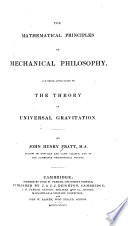 | John Henry Pratt - 1836 - 672 pages
...highly probable that the particles of the Sun attract the particles of the planets, and vice versa, with a force varying directly as the mass of the attracting particle and inversely as the square of the distance. 260. These consequences to which we have been led by Kepler's Laws are equally satisfied... | |
 | John Henry Pratt - 1845 - 694 pages
...highly probable that the particles of the Sun attract the particles of the planets, and vice versa, with a force varying directly as the mass of the attracting particle and inversely as the square of the distance. 260. These consequences to which we have been led by Kepler's Laws are equally satisfied... | |
 | Richard Potter - 1846 - 190 pages
...gravitation is, that every particle of matter attracts every other particle with a force which varies directly as the mass of the attracting particle, and inversely as the square of the distance. It is also shewn that a spherical body equally dense at equal distances from its center attracts... | |
 | Richard Potter - 1848 - 196 pages
...gravitation is, that every particle of matter attracts every other particle with a force which varies directly as the mass of the attracting particle, and inversely as the square of the distance. It is also shewn that a spherical body equally dense at equal distances from its center attracts... | |
 | 1852 - 512 pages
...symbolical representation of P will be ydO dy dx. And as the attraction on a point varies, in nature, directly as the mass of the attracting particle, and inversely as the square of the distance, the attractive influence of P on the Imagine any curve to be traced on the plane of the paper... | |
 | 1852 - 526 pages
...symbolical representation of P will be ydO dy dx. And as the attraction on a point varies, in nature, directly as the mass of the attracting particle, and inversely as the square of the distance, the attractive influence of P on the Imagine any curve to be traced on the plane of the paper... | |
 | William Holms Chambers Bartlett - 1853 - 462 pages
...inferred that the particles of the sun attract those of the planets, and vice versa, with ;i forco varying directly as the mass of the attracting particle, and inversely as the square of the distance. And from the experiments of Dr. Maskelyne, who found by observations on the fixed stars,... | |
 | Augustus William Smith - 1855 - 368 pages
...Gravitation is, that every particle of matter attracts every other particle with a force which varies directly as the mass of the attracting particle, and inversely as the square of the distance. A sphere of uniform density, or one whose density is the same at equal distances from the... | |
 | Augustus William Smith - 1855 - 340 pages
...Gravitation is, that every particle of matter attracts every other particle with a force which varies directly as the mass of the attracting particle, and inversely as the square of the distance. A sphere of uniform density, or one whose density is the same at equal distances from the... | |
 | Thomas Ewbank - 1858 - 170 pages
...in their turn the impellers. The established theory of cosmical movements is based on the principle that ' every particle in the universe attracts every other particle, with a force directly proportioned to the mass of the attracting particles and inversely to the square of the distance... | |
| |